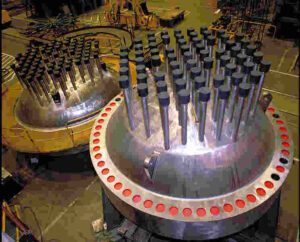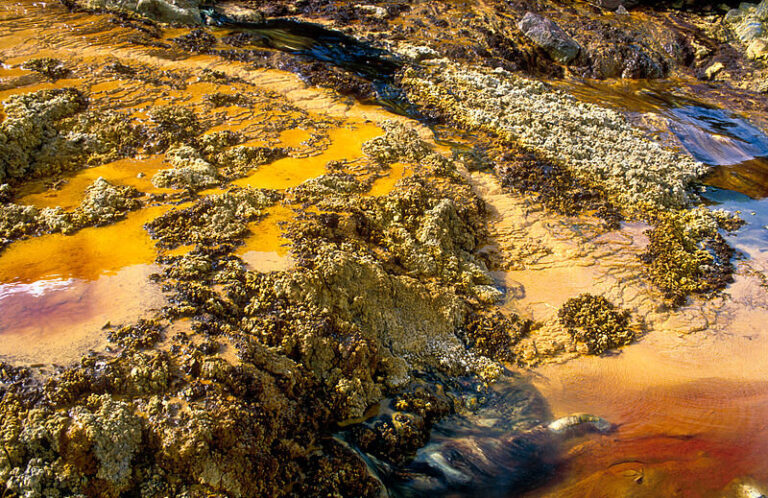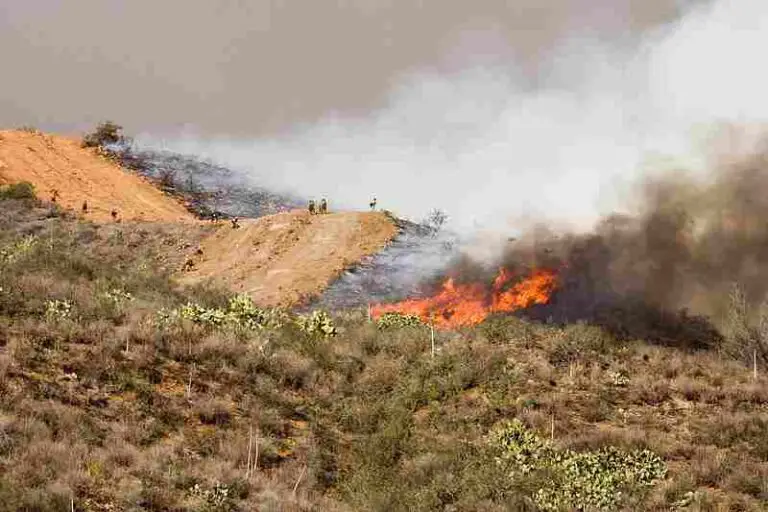Nuclear Energy Definition, History, Source, Principle and Uses
Nuclear energy is the binding force in atomic nuclei, which is released when these nuclei breakdown through radioactive decay. This article discusses nuclear energy definition, history, source, working principle, and uses, as outlined below;
-Nuclear Energy Definition: 5 Ways to Define Nuclear Energy
Nuclear Energy Definition: 5 Ways to Define Nuclear Energy
Nuclear energy is energy derived from the breakdown of radioactive materials (called nuclear fuels) which can occur under controlled conditions in a nuclear reactor.

The above is a basic outline of the meaning of nuclear energy, and indicates its primary source (radioactive materials). Below is an alternative nuclear energy definition which further highlights the materials or energy resources that produce nuclear energy;
Nuclear energy is the kind of energy that occurs in the nuclei of radioactive isotopes like plutonium-239 and uranium-235; and which is released when these isotopes are involved in reactions that lead to their chemical breakdown [2].
The next nuclear energy definition, focuses on the attributes and categorization of nuclear energy with regards to sustainability, as follows;
Nuclear energy is a clean, non renewable form of energy that is contained in the core or nucleus of an atom, and can be effectively extracted from some elements called radioisotopes, in order to be used for beneficial purposes.
As the above implies, nuclear energy is clean (that is; with minimal emission) and non-renewable. This characterization is supported by the fact that nuclear fuels ate finite resources which do not release any significant amount of greenhouse emissions during their fission.
Therefore, although it cannot be described as renewable energy, nuclear energy has minimal environmental impact, at least at the point of its extraction and use.
Some uses of nuclear energy are mentioned below, in the form of yet another nuclear energy definition;
Nuclear energy is a form of chemical energy from the nucleus of atoms, that is extracted through radioactive decay of isotopic elements, and used for various purposes that include marine vessel and spacecraft propulsion, electricity generation, medical diagnosis and treatment, industrial quality control and sustainable agriculture.
Lastly, examples of nuclear energy are mentioned in the nuclear energy definition, these being similar to the uses of nuclear energy that are mentioned above;
Nuclear energy is energy released during nuclear reactions, which is exemplified by natural solar energy production, medical radioscopy, food treatment applications, and domestic electricity generation.
History of Nuclear Energy
The history of nuclear energy timeline spans from the late eighteenth to mid-twentieth centuries; between 1789 and 1957.
It must be noted that while this timeline covers the most foundational developments in nuclear energy studies and technology, it is not the overall historical timeline of nuclear energy development, since efforts are constantly being made to advance the field and increase its relevance toward energy transition and sustainable development.
Italian physicist Enrico Fermi discovered nuclear energy as a result of research conducted in the 1930s and 1940s, that led to the successful creation of controlled nuclear chain reactions using neutrons and radioactive fuel [7].
However, the foundation for this achievement was laid through earlier discoveries.
German chemist Martin Klaproth discovered and characterized Uranium in 1789 [8], especially noting its attributes that made it prone to induced radioactive decay.
The neutron was discovered by James Chadwick in 1932 [6], shortly after which multiple independent researchers began to observe and analyze the potential of neutrons for radionuclide bombardment.
The original source of nuclear energy is the nucleus of an atom; where its function is to bind all components of the atoms firmly within a definite chemical structure. When radioactive elements breakdown chemically or 'decay', they are subjected to nuclear transformations that allow some of the stored energy to be released into the environment.
Another key period in the history of nuclear energy is the late 1930s to mid 1940s, during which nuclear materials and processes became the focus of military technological development in the Second World War.
This period, which spanned between 1939 and 1945, was used to develop and implement the atomic bomb [3].

Utilization of nuclear energy for propulsion of naval submarines and other vessels was also prominent during this period, and provided some of the insight that was used to integrate nuclear applications into space exploration.
Nuclear energy was first used on a notable scale in 1951, when a nuclear breeder reactor was first used to generate electricity in Idaho [5].
This experimental milestone was shortly followed by similar achievements, such as the implementation of the first nuclear power plant in the Soviet Union in 1954 [4].
Subsequent developments in nuclear energy technology have followed a similar path, involving primarily the optimization of reactors and radioactive pollution mitigation.
An effective pathway for controlled nuclear fusion is believed to have been discovered in late 2022 [1], as a potential improvement of the energy capacity of nuclear fission, which has been the main reaction mechanism used for nuclear power generation.
However, the full optimization of this approach may take a significant amount of time, before it can become fully practical and usable.
Nuclear Energy Source
The main nuclear energy source is the nucleus of an atom, from which the energy is extracted through nuclear reaction processes.
This implies that the sources of nuclear energy are the atom and its nuclear reaction processes respectively.
Elements whose nuclei can be split or chemically transformed to release nuclear energy must be fissile and relatively easy to break in the process of a nuclear reaction. These elements are isotopic, meaning that their proton and neutron configurations are capable of being modified.
The nuclear reaction processes that act as sources of nuclear energy are namely fusion and fission; where these signify nuclear bonding and splitting respectively.
Because they involve changes to the structure of the nucleus, these processes cause energy to be released.
How Nuclear Energy Works
Nuclear energy works by a three-step process of radioactive decay, energy capture, and energy conversion.
It must be noted that the outline of how nuclear energy works is different from that which explains how a nuclear reactor works.
Below is a brief description of how nuclear energy works step by step;
1). Radioactive Decay (in Explanation of How Nuclear Energy Works)
Radioactive decay is the first step in the working process and principle of nuclear energy.
It occurs when a radioactive isotope undergoes atomic breakdown and nuclear transformation, to yield a series of decay products.
Although radioactive decay occurs naturally, in the case of fission, it can also be induced in a laboratory or reactor through neutron bombardment of a target radioisotope.
Nuclear energy in the form of heat is usually released from radioactive decay.
2). Energy Capture
Energy capture is what occurs when the heat produced from radioactive decay is conveyed away from the point of its origin.
In nuclear reactors, this occurs through heat transfer, where a coolant fluid is used to absorb heat from the reaction system or core, in order to convey this heat away.
The purpose of energy capture is to transfer nuclear energy to the point where it will be converted.
3). Energy Conversion (in Explanation of How Nuclear Energy Works)
Energy conversion signifies the successful use of nuclear energy through its conversion to other energy or power forms.
The most common conversion pathway for nuclear energy is heat-to-mechanical; where a turbine is driven by nuclear heat-derived steam.
Mechanical energy produced is then used to power a generator for the production of electricity.
Uses of Nuclear Energy
Some uses of nuclear energy are;
1). Electricity generation
2). Spacecraft power supply
3). Nuclear imaging
4). Medical equipment sterilization
5). Food preservation
6). Cancer treatment
7). Submarine propulsion
Conclusion
Nuclear energy is the energy that binds protons and neutrons to the core of an atom; and which may be released through radioactive decay.
Nuclear energy sources are elements like uranium, and processes like radioactive fission and fusion.
Nuclear energy works in three steps that include;
1. Radioactive Decay
2. Energy Capture
3. Energy Conversion
Nuclear energy is used for; electricity generation, spacecraft power supply, nuclear imaging, medical equipment sterilization, food preservation, cancer treatment, and submarine propulsion.
References
1). Greshko, M. (2022). "Scientists achieve a breakthrough in nuclear fusion. Here’s what it means." Available at: https://www.nationalgeographic.com/science/article/scientists-achieve-breakthrough-nuclear-fusion. (Accessed 12 January 2023).
2). Grigoriev, Y.; Novikov-Borodin, A. (2016). "Power Installations based on Activated Nuclear Reactions of Fission and Synthesis." Delivered at the International Seminar on Interaction of Neutrons with Nuclei (ISINN-24), May 2016, Dubna, Russia. Available at: https://arxiv.org/abs/1606.04389. (Accessed 15 January 2021).
3). Holloway, D. (2016). "Entering the Nuclear Arms Race: The Soviet Decision to Build the Atomic Bomb, 1939-45." Social Studies of Science, Volume 11, Issue 2. Available at: https://doi.org/10.1177/030631278101100201. (Accessed 15 January 2023).
4). Ichikawa, H. (2016). "Obninsk, 1955: The world's first nuclear power plant and "the atomic diplomacy" by Soviet scientists." Available at: https://www.jstage.jst.go.jp/article/historiascientiarum/26/1/26_25/_article/-char/ja/. (Accessed 15 January 2023).
5). Khairunnisa, N. F.; Ashri, M.; Maskun, M. (2017). "Indonesian Implementation of Nuclear Energy for Sustainable Development." Journal of Law, Policy and Globalization. Available at: https://www.iiste.org/Journals/index.php/JLPG/article/view/39955. (Accessed 15 January 2023).
6). Nesvizhevsky, V. V.; Villain, J. (2017). "The discovery of the neutron and its consequences (1930–1940)." Comptes Rendus Physique 18(9-10). Available at: https://doi.org/10.1016/j.crhy.2017.11.001. (Accessed 15 January 2023).
7). Nunez, C. (2019). "What is nuclear energy and is it a viable resource?" Available at: https://www.nationalgeographic.com/environment/article/nuclear-energy. (Accessed 12 January 2023).
8). Tsoureas, N.; Mansikkamäki, A.; Layfield, R. A. (2019). "Uranium(IV) cyclobutadienyl sandwich compounds: synthesis, structure and chemical bonding." Chemical Communications 56(6). Available at: https://doi.org/10.1039/C9CC09018E. (Accessed 15 January 2023).





